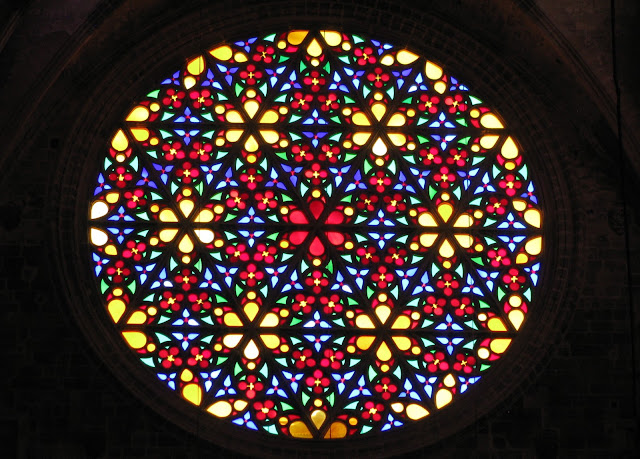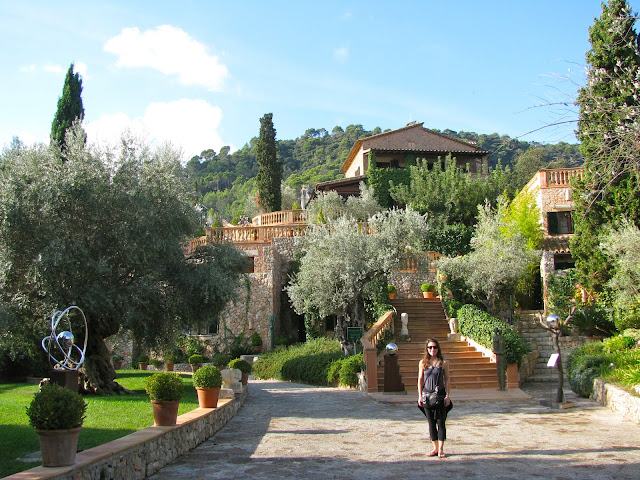Kirker Holidays rocks! This is the scene in our hotel room minutes after arriving in Palma, Mallorca. The Romans founded Palmaria around the 1st century BC, but it was the Moors who transformed the settlement into a major city. Although much of the city’s Muslim past was destroyed by the Christian Reconquest and subsequently fire, Palma’s old center is still rich with medieval and Renaissance churches and historic manor houses.
But before we head out for some sightseeing we need some tapas at La Boveda where it’s all about the ham and the lemon sorbet shooters.
The graceful and imposing Catedral (La Seu) is one of Europe’s great churches, and the greatest architectural achievement in the Balearic Islands. It was constructed 1229-1601 on the site of the Great Mosque, which was the centerpiece of Moorish Mallorca. With it’s soaring buttresses flanking a waterfront park and reflecting pool, it’s an arresting sight.
Inside are glorious Gothic altars, a huge stained glass rose window and decidedly unexpected later artistic interventions such as an iron canopy suspended over the principal altar.
This massive solid silver candelabra makes Tim smile.
A peek into one of Palma’s baronial mansion’s inner courtyard.
Tim in front of the grand doors of the Basilica de Sant Francesc.
The Franciscan Basilica de Sant Francesc was built in the Gothic style beginning in 1281. Standing watch over it is a statue of Juniper Serra, the native Mallorcan who founded Franciscan missions in California and Baja California in the 18th century.
The decorative facade of the Basilica de Sant Francesc.
The ethereal, two-storey Gothic cloisters and their delightfully sculpted columns and fragrant orange and lemon trees.
The ornate early 18th century altarpiece is a highlight.
The chapel holds the remains of the 13th century Mallorcan philosopher and mystic Ramon Llull.
Palma’s oldest cafe, Ca’n Joan de S’Aigo, was founded in 1697. Technically it’s a milk bar, tucked away on a side street. With marble-topped tables, antique chandeliers and tiled floors, Sandi tries the house specialty—hot chocolate.
Plaça Major, Palma’s principal square.
Facing the cathedral is the opulent Spanish royal palace, the official summer residence of King Juan Carlos and Queen Sofia, constructed on the site of the former Moorish royal palace and fortress.
We hire a car and drive to Port d’Andratx. Previously a sleepy fishing village, the sheltered natural harbour has gone genteel, with yachts bobbing in the marina and elegantly dressed visitors and summer homeowners sipping cocktails in waterfront cafes.
Not-so-elegantly-dressed visitors are welcome to sip cocktails on the waterfront too.
The Mirador de Ses Animes (Toree del Verger) is perhaps the finest viewpoint of the entire coast. The 16th century tower clings to the very edge of the cliff.
We climb the slender ladder to the top for the most captivating views.
The picturesque village of Deià is perched on a hillside with honey-coloured stone houses, tiled roofs and green shuttered windows. Deià’s beauty has long-attracted expat artists, prominent among them Robert Graves, the author of I, Claudius, who made his home here in 1929.
Tucked into a valley along the northwest coast, Valldemossa is one of Mallorca’s most celebrated historic towns, best known for the Reial Cartoixa monastery. The Polish composer Frédéric Chopin and his lover, writer George Sand, spent one miserable winter (1838-39) in the monastery, later immortalized in Sand’s book, A Winter in Mallorca.
We stay at the Hotel Valldemossa and this is the stunning view from the balcony of our room with the monastery in the background.
The entrance of Hotel Valldemossa is absolutely beautiful.
A bronze sculpture of Chopin graces the courtyard of the Reial Cartoixa de Valldemossa.
The Reial Cartoixa de Valldemossa with it's distinctive green-tiled bell tower, dates to the 14th century but what we see today are neoclassical 17th and 18th century buildings. In addition to monk cells (incredibly only 13 brothers lived here at a time), there are rooms dedicated to Chopin and Sand, a pharmacy, library, and a church.
First we pass through the church.
Then are greeted by the couple themselves, George and Fred.
The Carthusian Pharmacy was founded by the monks at the beginning of the 18th century. It contains earthenware jars, glass bottles, gourds, scales, mortars, pill boxes etc. A collection of 135 Catalan ceramic jars decorated with figures, plants and animal motifs in blue served a double purpose; they were not only used to contain the medical preparations but also to embellish the pharmacy.
Portrait of George Sand.
Valldemossa’s pretty cobbled streets.
As we drive out of Valldemossa we get caught in a huge rain storm and have to pull off the road for an hour to wait it out. This is all we see out the windshield. Good time for a siesta.






















































No comments:
Post a Comment